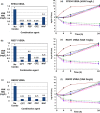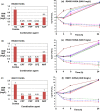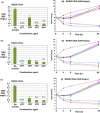β-Lactam Combinations with Vancomycin Show Synergistic Activity against Vancomycin-Susceptible Staphylococcus aureus, Vancomycin-Intermediate S. aureus (VISA), and Heterogeneous VISA
- PMID: 29555635
- PMCID: PMC5971571
- DOI: 10.1128/AAC.00157-18
β-Lactam Combinations with Vancomycin Show Synergistic Activity against Vancomycin-Susceptible Staphylococcus aureus, Vancomycin-Intermediate S. aureus (VISA), and Heterogeneous VISA
Abstract
Increasing utilization of vancomycin due to the high prevalence of methicillin-resistant Staphylococcus aureus (MRSA) infections has led to the emergence of vancomycin-intermediate S. aureus (VISA) and heterogeneous VISA (hVISA) strains. In vitro data suggest the potential for potent synergy between several beta-lactams and vancomycin. The objective of this study is to evaluate the synergy between beta-lactams and vancomycin against MRSA that is vancomycin susceptible, vancomycin-susceptible Staphylococcus aureus (VSSA), hVISA, and VISA. Fifty randomly selected clinical MRSA strains with various susceptibility levels to vancomycin were evaluated for vancomycin alone and vancomycin in combination with various concentrations of cefazolin (CFZ), cefepime (FEP), ceftaroline (CPT), and nafcillin (NAF). The potential for synergy was assessed by 24-h time-kill studies. Beta-lactams reduced vancomycin MIC values against all strains (4- to 16-fold reduction). In time-kill studies against MRSA, CFZ, FEP, CPT, and NAF all demonstrated similar degrees of killing at 24 h, and all showed synergistic activity with vancomycin against VSSA, hVISA, and VISA. Each of these combinations was also superior to any single agent against isolates of all three phenotypes, and each was bactericidal (P < 0.001 for all comparisons). All single-agent exposures demonstrated no activity at 24 h. The combination of vancomycin and beta-lactams significantly improved antibacterial activity against VSSA, hVISA, and VISA strains compared to the activity of any agent alone, supporting the potential use of vancomycin-beta-lactam combination therapy in infections caused by MRSA. Further clinical research is warranted to investigate the synergy of vancomycin against these Staphylococcus strains.
Keywords: MRSA; Staphylococcus aureus; cefazolin; cefepime; ceftaroline; combination therapy; in vitro; infection; nafcillin; time kill; vancomycin.
Copyright © 2018 American Society for Microbiology.
Figures



Similar articles
-
Oritavancin Combinations with β-Lactams against Multidrug-Resistant Staphylococcus aureus and Vancomycin-Resistant Enterococci.Antimicrob Agents Chemother. 2016 Mar 25;60(4):2352-8. doi: 10.1128/AAC.03006-15. Print 2016 Apr. Antimicrob Agents Chemother. 2016. PMID: 26833159 Free PMC article.
-
Synergistic effect of vancomycin combined with cefotaxime, imipenem, or meropenem against Staphylococcus aureus with reduced susceptibility to vancomycin.Turk J Med Sci. 2021 Aug 30;51(4):2150-2158. doi: 10.3906/sag-1910-166. Turk J Med Sci. 2021. PMID: 33705643 Free PMC article.
-
Combinations of (lipo)glycopeptides with β-lactams against MRSA: susceptibility insights.J Antimicrob Chemother. 2020 Oct 1;75(10):2894-2901. doi: 10.1093/jac/dkaa237. J Antimicrob Chemother. 2020. PMID: 32591820
-
Clinical implications of vancomycin heteroresistant and intermediately susceptible Staphylococcus aureus.Pharmacotherapy. 2015 Apr;35(4):424-32. doi: 10.1002/phar.1577. Pharmacotherapy. 2015. PMID: 25884530 Review.
-
Staphylococcus aureus response and adaptation to vancomycin.Adv Microb Physiol. 2024;85:201-258. doi: 10.1016/bs.ampbs.2024.04.006. Epub 2024 Jun 1. Adv Microb Physiol. 2024. PMID: 39059821 Review.
Cited by
-
Adjunctive ceftaroline in combination with daptomycin or vancomycin for complicated methicillin-resistant Staphylococcus aureus bacteremia after monotherapy failure.Ther Adv Infect Dis. 2019 Nov 7;6:2049936119886504. doi: 10.1177/2049936119886504. eCollection 2019 Jan-Dec. Ther Adv Infect Dis. 2019. PMID: 31857898 Free PMC article.
-
Monotherapy with Vancomycin or Daptomycin versus Combination Therapy with β-Lactams in the Treatment of Methicillin-Resistant Staphylococcus Aureus Bloodstream Infections: A Retrospective Cohort Analysis.Infect Dis Ther. 2020 Jun;9(2):325-339. doi: 10.1007/s40121-020-00292-8. Epub 2020 Apr 4. Infect Dis Ther. 2020. PMID: 32248513 Free PMC article.
-
Focusing the Lens on the CAMERA Concepts: Early Combination β-Lactam and Vancomycin Therapy in Methicillin-Resistant Staphylococcus aureus Bacteremia.Antimicrob Agents Chemother. 2020 Jun 23;64(7):e00360-20. doi: 10.1128/AAC.00360-20. Print 2020 Jun 23. Antimicrob Agents Chemother. 2020. PMID: 32366709 Free PMC article. Review.
-
Dalbavancin, Vancomycin and Daptomycin Alone and in Combination with Cefazolin against Resistant Phenotypes of Staphylococcus aureus in a Pharmacokinetic/Pharmacodynamic Model.Antibiotics (Basel). 2020 Oct 14;9(10):696. doi: 10.3390/antibiotics9100696. Antibiotics (Basel). 2020. PMID: 33066415 Free PMC article.
-
Cell wall thickness and the molecular mechanism of heterogeneous vancomycin-intermediate Staphylococcus aureus.Lett Appl Microbiol. 2021 May;72(5):604-609. doi: 10.1111/lam.13456. Epub 2021 Feb 15. Lett Appl Microbiol. 2021. PMID: 33539564 Free PMC article.
References
-
- Lin SH, Liao WH, Lai CC, Liao CH, Tan CK, Wang CY, Huang YT, Hsueh PR. 2010. Risk factors for mortality in patients with persistent methicillin-resistant Staphylococcus aureus bacteremia in a tertiary care hospital in Taiwan. J Antimicrob Chemother 65:1792–1798. doi:10.1093/jac/dkq188. - DOI - PubMed
-
- Welsh KJ, Abbott AN, Lewis EM, Gardiner JM, Kruzel MC, Lewis CT, Mohr JF, Wanger A, Armitige LY. 2010. Clinical characteristics, outcomes, and microbiologic features associated with methicillin-resistant Staphylococcus aureus bacteremia in pediatric patients treated with vancomycin. J Clin Microbiol 48:894–899. doi:10.1128/JCM.01949-09. - DOI - PMC - PubMed
-
- Bae IG, Federspiel JJ, Miro JM, Woods CW, Park L, Rybak MJ, Rude TH, Bradley S, Bukovski S, de la Maria CG, Kanj SS, Korman TM, Marco F, Murdoch DR, Plesiat P, Rodriguez-Creixems M, Reinbott P, Steed L, Tattevin P, Tripodi MF, Newton KL, Corey GR, Fowler VG Jr, International Collaboration on Endocarditis-Microbiology Investigator. 2009. Heterogeneous vancomycin-intermediate susceptibility phenotype in bloodstream methicillin-resistant Staphylococcus aureus isolates from international cohort of patients with infective endocarditis: prevalence, genotype, and clinical significance. J Infect Dis 200:1355–1366. doi:10.1086/606027. - DOI - PMC - PubMed
Publication types
MeSH terms
Substances
Grants and funding
LinkOut - more resources
Full Text Sources
Other Literature Sources
Medical
Miscellaneous

